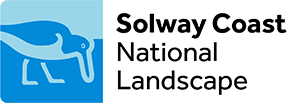The sand and mud of the Solway Coast National Landscape hides a fantastic array of plants and animals that can easily be overlooked.
Under the rippled sand lies a whole world of life, from small animals such as crabs and worms to the larger shellfish like the razor shell, or the tiny Baltic tellin – a bi-valve shellfish, so called because it has two shells to protect it.
All of these creatures are just above the bottom of the food chain and they live on the primary producers such as plants and organic detritus. The millions of birds and fish that use the Solway, either on migration or as residents, in turn, eat these animals.
The estuary is governed by the daily ebb and flow of the tide, and all of the plants and animals respond to this in a multitude of ways. There are the spectacular flights of wintering wading birds, porpoises chasing shoals of fish, and even the traditional haaf net fishermen who use the tides to catch salmon and sea trout.
The sand and mud flats are the engine room from which all other life around the estuary is dependent. They are such important habitats that they all covered under national, European and global nature conservation designations.
